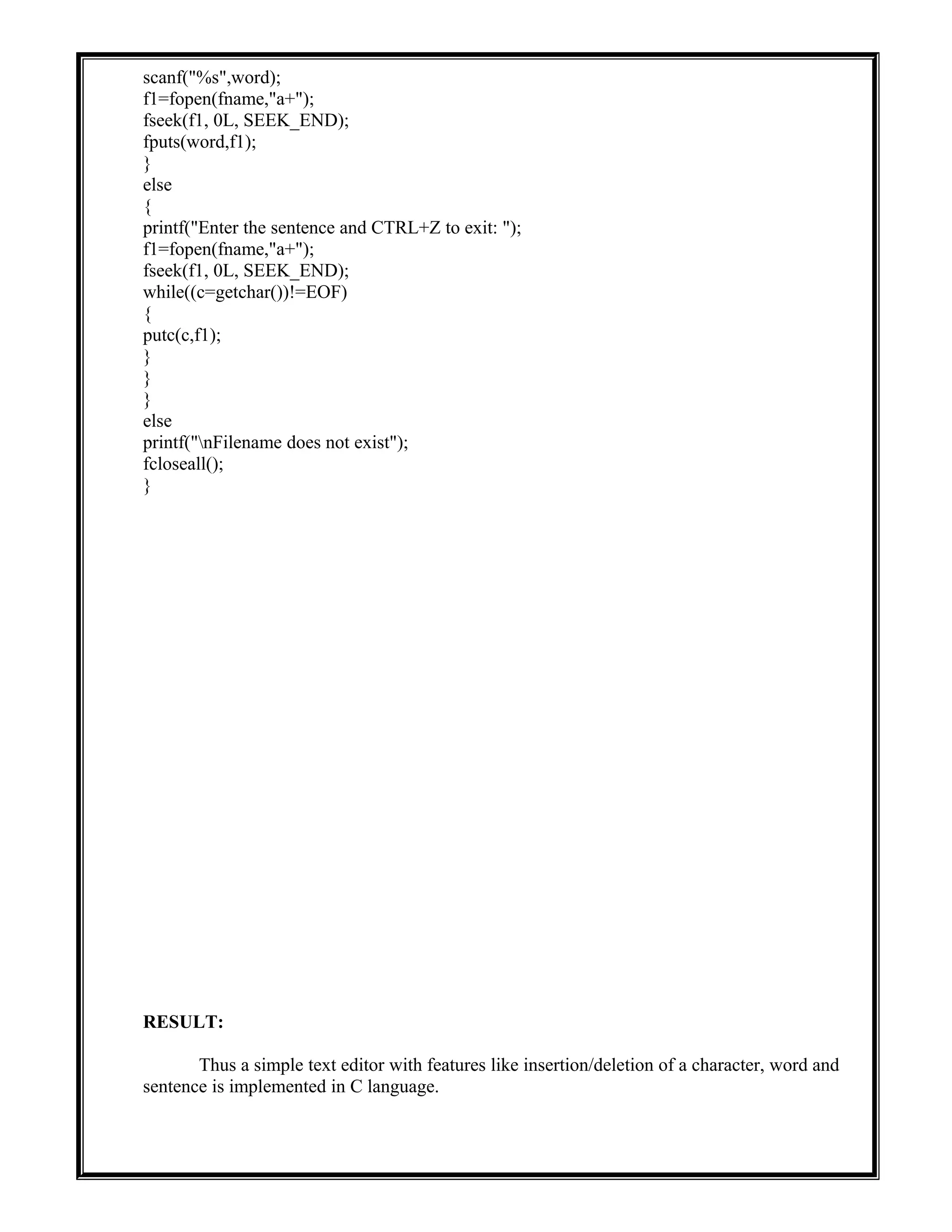This document contains the syllabus for the IT2307 SYSTEM SOFTWARE LAB course. It includes implementing various system software components like symbol tables, assemblers, loaders, text editors, and more using C language. 12 different programming assignments are listed that cover topics like implementing the different passes of assemblers, macro processors, loaders, and a basic text editor.

![SYMBOL TABLE
AIM:
To implement a Symbol table with functions to create, insert, modify, search and display
in C language.
ALGORITHM:
1. Start the program
2. Define the structure of the symbol table
3. Enter the choice for performing the operations in the symbol table
4. If choice is 1, search symbol table for the symbol to be inserted. If the symbol is already
present display “Duplicate Symbol”, else insert symbol and corresponding address in the
symbol table
5. If choice is 2, symbols present in the symbols table are displayed
6. If choice is 3, symbol to be deleted is searched in the symbol table, if found deletes else
displays “Not Found”.
7. If choice is 5, the symbol to be modified is searched in the symbol table. The label or
address or both can be modified.
PROGRAM:
/* C Program to implement SYMBOL TABLE */
#include<stdio.h>
#include<conio.h>
#include<alloc.h>
#include<string.h>
#define null 0
int size=0;
void insert();
void del();
int search(char lab[]);
void modify();
void display();
struct symbtab
{
char label[10];
int addr;
struct symbtab *next;
};
struct symbtab *first,*last;
void main()
{
int op;
int y;
char la[10];
clrscr();](https://image.slidesharecdn.com/35787646-system-software-lab-manual-150426114600-conversion-gate01/75/35787646-system-software-lab-manual-2-2048.jpg)
![do
{
printf("nSYMBOL TABLE IMPLEMENTATIONn");
printf("1.INSERTn");
printf("2.DISPLAYn");
printf("3.DELETEn");
printf("4.SEARCHn");
printf("5.MODIFYn");
printf("6.ENDn");
printf("nEnter your option: ");
scanf("%d",&op);
switch(op)
{
case 1:
insert();
display();
break;
case 2:
display();
break;
case 3:
del();
display();
break;
case 4:
printf("Enter the label to be searched: ");
scanf("%s",la);
y=search(la);
if(y==1)
printf("The label is already in the symbol tablen");
else
printf("The label is not found in the symbol tableln");
break;
case 5:
modify();
display();
break;
case 6:
break;
}
}while(op<6);
getch();
}
void insert()
{
int n;
char l[10];
printf("Enter the label: ");
scanf("%s",l);
n=search(l);
if(n==1)](https://image.slidesharecdn.com/35787646-system-software-lab-manual-150426114600-conversion-gate01/75/35787646-system-software-lab-manual-3-2048.jpg)
![printf("The label is already in the symbol table. Duplicate cant be insertedn");
else
{
struct symbtab *p;
p=malloc(sizeof(struct symbtab));
strcpy(p->label,l);
printf("Enter the address: ");
scanf("%d",&p->addr);
p->next=null;
if(size==0)
{
first=p;
last=p;
}
else
{
last->next=p;
last=p;
}
size++;
}
}
void display()
{
int i;
struct symbtab *p;
p=first;
printf("LABELtADDRESSn");
for(i=0;i<size;i++)
{
printf("%st%dn",p->label,p->addr);
p=p->next;
}
}
int search(char lab[])
{
int i,flag=0;
struct symbtab *p;
p=first;
for(i=0;i<size;i++)
{
if(strcmp(p->label,lab)==0)
{
flag=1;
}
p=p->next;
}
return flag;
}
void modify()
{](https://image.slidesharecdn.com/35787646-system-software-lab-manual-150426114600-conversion-gate01/75/35787646-system-software-lab-manual-4-2048.jpg)
![char l[10],nl[10];
int add,choice,i,s;
struct symbtab *p;
p=first;
printf("What do you want to modify?n");
printf("1.Only the labeln");
printf("2.Only the address of a particular labeln");
printf("3.Both the label and addressn");
printf("Enter your choice: ");
scanf("%d",&choice);
switch(choice)
{
case 1:
printf("Enter the old labeln");
scanf("%s",l);
printf("Enter the new label: ");
scanf("%s",nl);
s=search(l);
if(s==0)
printf("nNo such label");
else
{
for(i=0;i<size;i++)
{
if(strcmp(p->label,l)==0)
{
strcpy(p->label,nl);
}
p=p->next;
}
}
break;
case 2:
printf("Enter the label whose address is to be modified: ");
scanf("%s",l);
printf("Enter the new address: ");
scanf("%d",&add);
s=search(l);
if(s==0)
printf("nNo such label");
else
{
for(i=0;i<size;i++)
{
if(strcmp(p->label,l)==0)
{
p->addr=add;
}
p=p->next;
}
}](https://image.slidesharecdn.com/35787646-system-software-lab-manual-150426114600-conversion-gate01/75/35787646-system-software-lab-manual-5-2048.jpg)
![break;
case 3:
printf("Enter the old label: ");
scanf("%s",l);
printf("Enter the new label: ");
scanf("%s",nl);
printf("Enter the new address: ");
scanf("%d",&add);
s=search(l);
if(s==0)
printf("nNo such label");
else
{
for(i=0;i<size;i++)
{
if(strcmp(p->label,l)==0)
{
strcpy(p->label,nl);
p->addr=add;
}
p=p->next;
}
}
break;
}
}
void del()
{
int a;
char l[10];
struct symbtab *p,*q;
p=first;
printf("Enter the label to be deleted: ");
scanf("%s",l);
a=search(l);
if(a==0)
printf("Label not foundn");
else
{
if(strcmp(first->label,l)==0)
first=first->next;
else if(strcmp(last->label,l)==0)
{
q=p->next;
while(strcmp(q->label,l)!=0)
{
p=p->next;
q=q->next;
}
p->next=null;
last=p;](https://image.slidesharecdn.com/35787646-system-software-lab-manual-150426114600-conversion-gate01/75/35787646-system-software-lab-manual-6-2048.jpg)
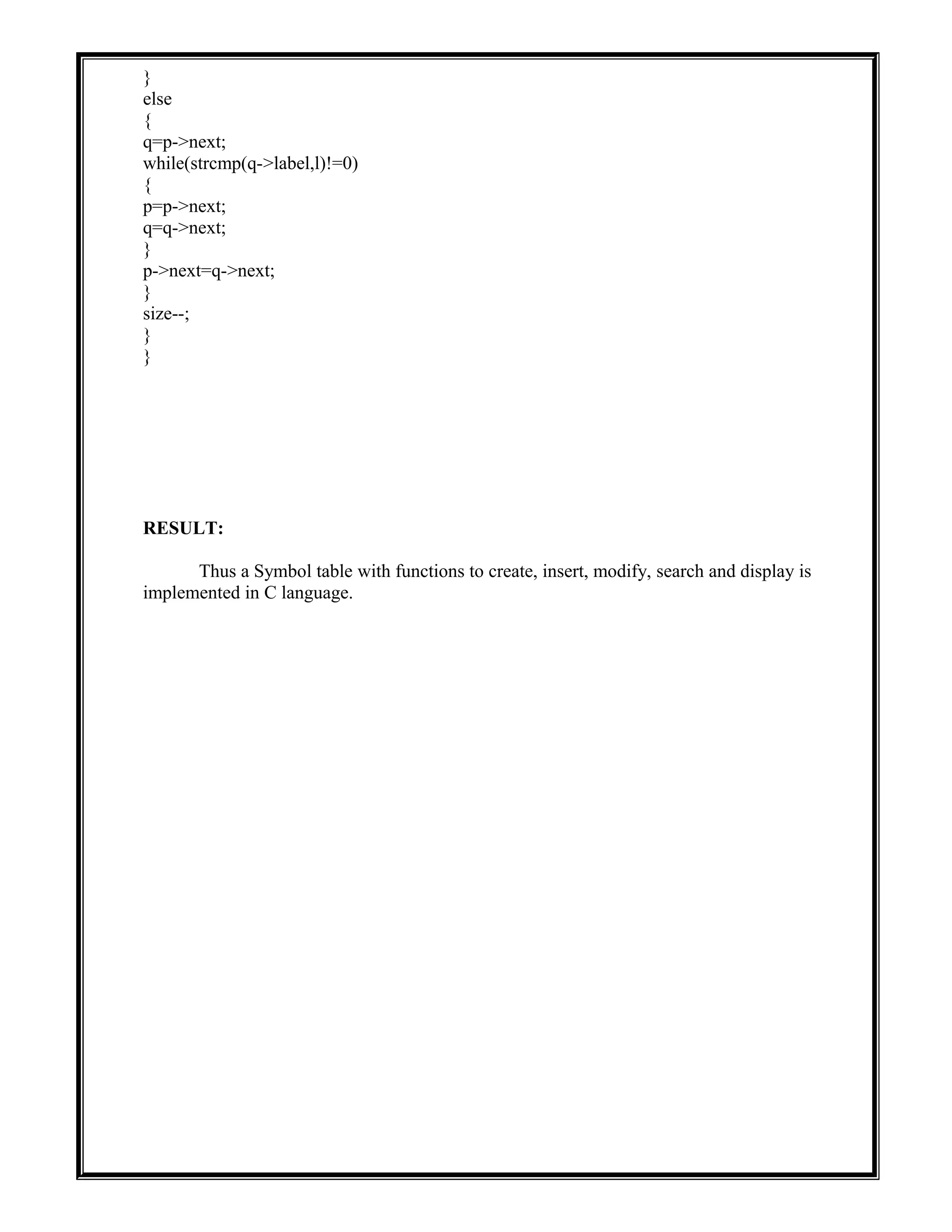
![Ex.No: 02
PASS ONE OF TWO PASS ASSEMBLER
AIM:
To implement pass one of a two pass assembler in C language.
ALGORITHM:
1. Open and Read the input file
2. If the input line has the opcode “START” do the following
2.1 Find if there is any operand field after “START”, initialize the LOCCTR to the
operand value
2.2 Otherwise if there is no value in the operand field then LOCCTR is set to 0
3. Write the input line to the intermediate file
4. Do the following steps until the opcode is END
4.1 Check the Symbol table, if the symbol is not available then enter that symbol into
the SYMTAB, along with the memory address in which it is stored.Otherwise, the
error message should be displayed
4.2 If there is a opcode
4.2.1 If opcode is present in the OPTAB, then increment the LOCCTR by 3
4.2.2 If opcode is “WORD”, then increment LOCCTR by 3;
4.2.3 If opcode is “BYTE”, then increment LOCCTR by 1;
4.2.4 If opcode is “RESW” then increment LOCCTR by the integer equivalent
of the operand value * 3;
4.2.5 If opcode is “RESB”, then increment LOCCTR by the integer equivalent
of the operand value
4.3 Write the processed lines in the intermediate file along with their location
counters
5. To find the length of the program, Subtract the starting address of the program from the
final value of the LOCCTR
6. Close all the files and exit
PROGRAM:
/* C Program to implement PASS ONE OF TWO PASS ASSEMBLER */
#include<stdio.h>
#include<conio.h>
#include<string.h>
#include<stdlib.h>
void main()
{
char opcode[10],mnemonic[10],operand[10],label[10],code[10];
int locctr,start,length;
FILE *fp1,*fp2,*fp3,*fp4;
clrscr();
fp1=fopen("input.dat","r");
fp2=fopen("symtab.dat","w");](https://image.slidesharecdn.com/35787646-system-software-lab-manual-150426114600-conversion-gate01/75/35787646-system-software-lab-manual-8-2048.jpg)
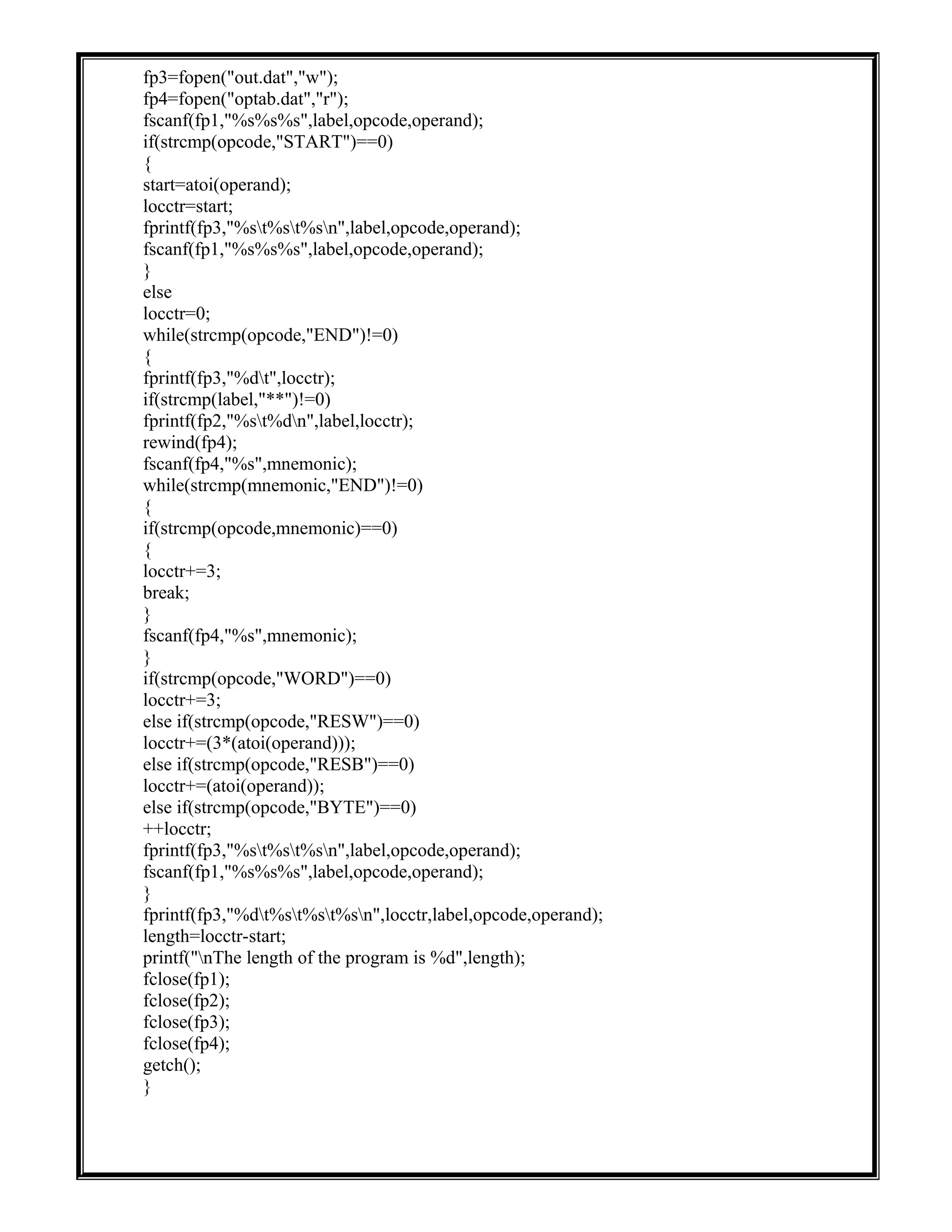
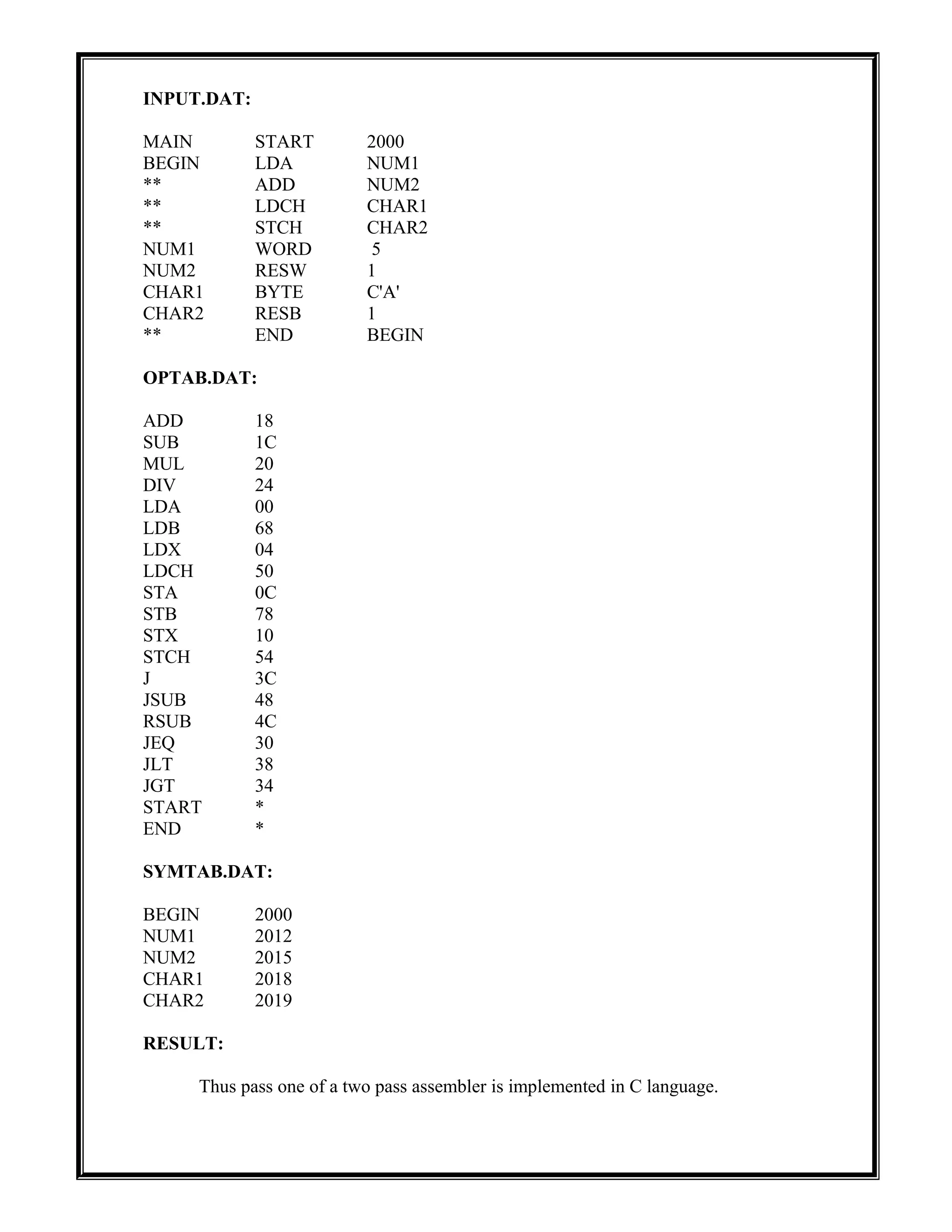
![Ex.No: 03
PASS TWO OF TWO PASS ASSEMBLER
AIM:
To implement pass two of a two pass assembler in C language.
ALGORITHM:
1. Open and read the first line from the intermediate file.
2. If the first line contains the opcode “START”, then write the label, opcode and operand
field values of the corresponding statement directly to the final output file.
3. Do the following steps, until an “END” statement is reached.
3.1 Start writing the location counter, opcode and operand fields of the corresponding
statement to the output file, along with the object code.
3.2 If there is no symbol/label in the operand field, then the operand address is assigned
as zero and it is assembled with the object code of the instruction
3.3 If the opcode is BYTE, WORD, RESB etc convert the constants to the object code.
4. Close the files and exit
PROGRAM:
/* C Program to implement PASS TWO OF TWO PASS ASSEMBLER */
#include<stdio.h>
#include<conio.h>
#include<string.h>
#include<stdlib.h>
void main()
{
char a[10],ad[10],label[10],opcode[10],operand[10],mnemonic[10],symbol[10];
int i,locctr,code,add,len,actual_len;
FILE *fp1,*fp2,*fp3,*fp4;
clrscr();
fp1=fopen("twoout.dat","w");
fp2=fopen("symtab.dat","r");
fp3=fopen("out.dat","r");
fp4=fopen("optab.dat","r");
fscanf(fp3,"%s%s%s",label,opcode,operand);
if(strcmp(opcode,"START")==0)
{
fprintf(fp1,"t%st%st%sn",label,opcode,operand);
fscanf(fp3,"%d%s%s%s",&locctr,label,opcode,operand);
}
while(strcmp(opcode,"END")!=0)
{
if(strcmp(opcode,"BYTE")==0)
{
fprintf(fp1,"%dt%st%st%st",locctr,label,opcode,operand);
len=strlen(operand);](https://image.slidesharecdn.com/35787646-system-software-lab-manual-150426114600-conversion-gate01/75/35787646-system-software-lab-manual-11-2048.jpg)
![actual_len=len-3;
for(i=2;i<(actual_len+2);i++)
{
itoa(operand[i],ad,16);
fprintf(fp1,"%s",ad);
}
fprintf(fp1,"n");
}
else if(strcmp(opcode,"WORD")==0)
{
len=strlen(operand);
itoa(atoi(operand),a,10);
fprintf(fp1,"%dt%st%st%st00000%sn",locctr,label,opcode,operand,a);
}
else if((strcmp(opcode,"RESB")==0)||(strcmp(opcode,"RESW")==0))
{
fprintf(fp1,"%dt%st%st%sn",locctr,label,opcode,operand);
}
else
{
rewind(fp4);
fscanf(fp4,"%s%d",mnemonic,&code);
while(strcmp(opcode,mnemonic)!=0)
fscanf(fp4,"%s%d",mnemonic,&code);
if(strcmp(operand,"**")==0)
{
fprintf(fp1,"%dt%st%st%st%d0000n",locctr,label,opcode,operand,code);
}
else
{
rewind(fp2);
fscanf(fp2,"%s%d",symbol,&add);
while(strcmp(operand,symbol)!=0)
{
fscanf(fp2,"%s%d",symbol,&add);
}
fprintf(fp1,"%dt%st%st%st%d%dn",locctr,label,opcode,operand,code,add);
}
}
fscanf(fp3,"%d%s%s%sn",&locctr,label,opcode,operand);
}
fprintf(fp1,"%dt%st%st%sn",locctr,label,opcode,operand);
printf("FINISHED");
fclose(fp1);
fclose(fp2);
fclose(fp3);
fclose(fp4);
getch();
}](https://image.slidesharecdn.com/35787646-system-software-lab-manual-150426114600-conversion-gate01/75/35787646-system-software-lab-manual-12-2048.jpg)
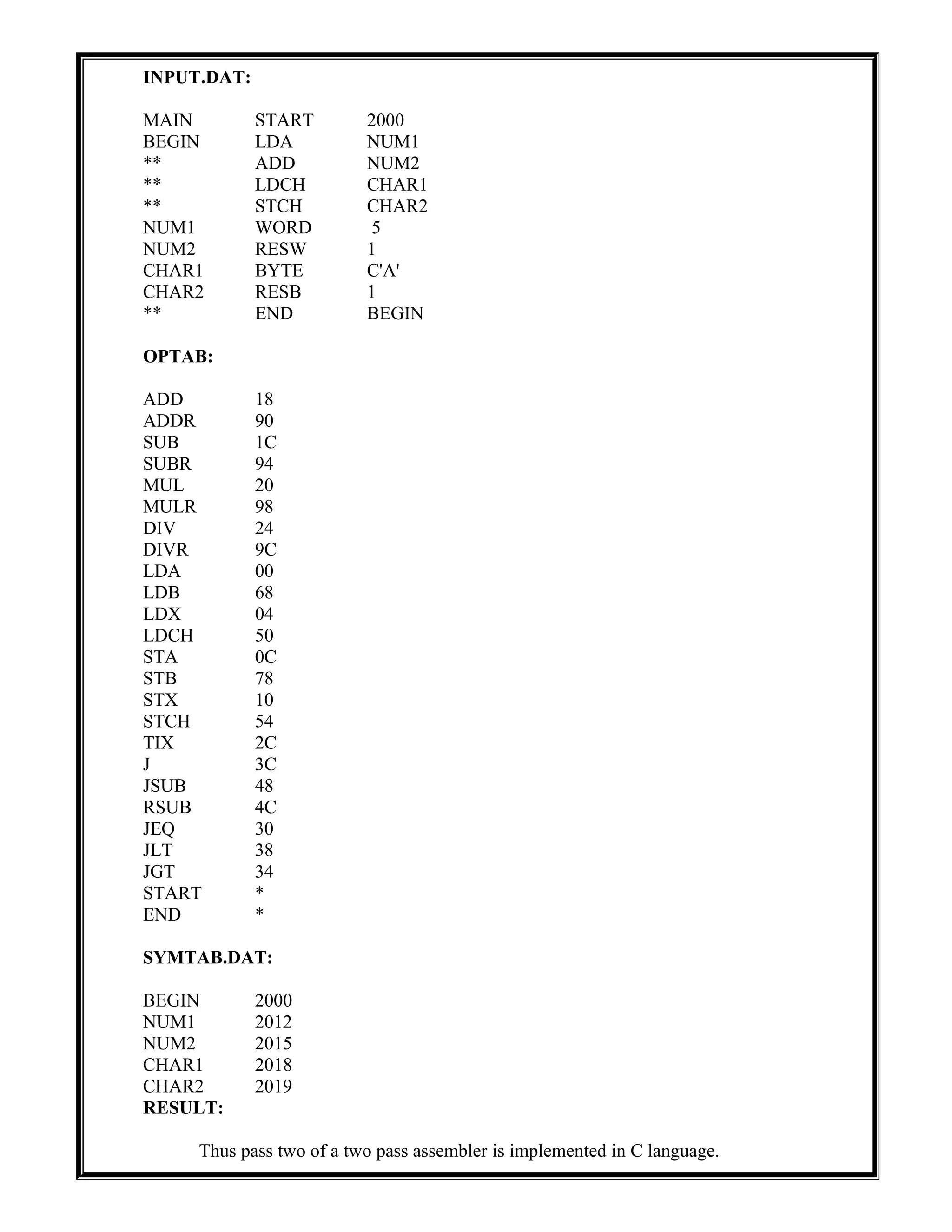
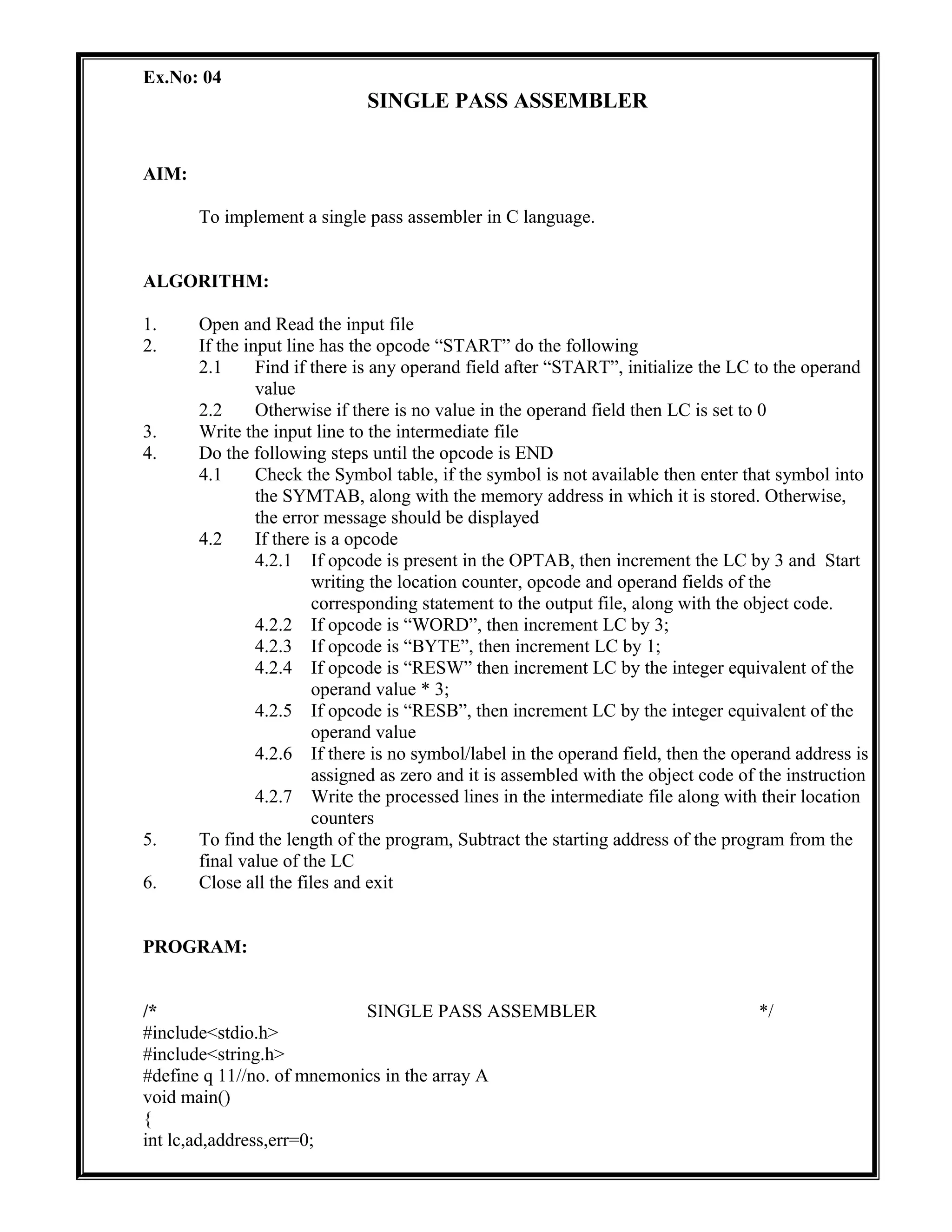
![int s,num,l,i=0,j,n=0,line=1,f=0,f1=0,t=0,ni=0,m=0,t1;
FILE *fp1,*fp2,*fp3,*fp4;
char lab[10],op[10],val[10],code[10];
char a[20]
[15]={"STA","STL","LDA","LDB","J","JEQ","J","SUB","COMP","STCH","ADD","SUB"};
char b[20][15]={"14","32","03","69","34","30","48","28","24","16","0C"};
char sym[15][10];
int symadd[15];
clrscr();
fp1=fopen("INPUT.DAT","r");
fp2=fopen("OBJFILE.DAT","w");
fp3=fopen("ERROR.DAT","w");
fp4=fopen("SYMTAB.DAT","w");
while((!feof(fp1)))
{
fscanf(fp1,"%st%st%s",lab,op,val);
t++;
m++;
if(strcmp(op,".")==0)
m=0;
else if(strcmp(op,"END")==0)
break;
}
t=t-1;
m--;
fclose(fp1);
fp1=fopen("INPUT.DAT","r");
fscanf(fp1,"%st%st%x",lab,op,&lc);
fprintf(fp3,"-------------------------------------n");
fprintf(fp3,"LINE NO.t|ERROR FOUNDn");
fprintf(fp3,"-------------------------------------");
fprintf(fp4,"SYMBOLtADDRESS");
s=lc;
fprintf(fp2,"H^%s^00%x^%xn",lab,lc,t*3);
fprintf(fp2,"T^00%x^",lc);
if(m>10)
fprintf(fp2,"1E");
else
fprintf(fp2,"%x",m*3);
while((op,".")!=0&&(!feof(fp1)))
{
fscanf(fp1,"%st%st%s",lab,op,val);
line++;
if(strcmp(lab,"$")!=0)
{
for(i=0;i<n;i++)
{
if(strcmp(lab,sym[i])==0)
{
f=1;
break;](https://image.slidesharecdn.com/35787646-system-software-lab-manual-150426114600-conversion-gate01/75/35787646-system-software-lab-manual-15-2048.jpg)
![}
f=0;
}
if(f==0)
{
strcpy(sym[n],lab);
symadd[n]=lc;
fprintf(fp4,"n%st%x",lab,lc);
n++;
}
if(f==1){
fprintf(fp3,"%dtt|SYMBOL ALREADY DEFINEDn",line);err++;}
}
num=atoi(val);
if(strcmp(op,"RESW")==0)
lc=lc+(num*3);
else if(strcmp(op,"RESB")==0)
lc=lc+num;
else if(strcmp(op,"BYTE")==0)
{
num=strlen(val)-3;
lc=lc+num;
for(i=2,j=0;i<strlen(val)-1;i++)
{
code[j]=val[i];
j++;
}
code[j]='0';
fprintf(fp2,"^%s",code);
ni++;
}
else
lc=lc+3;
if(strcmp(op,".")==0)
break;
}
while(strcmp(op,"END")!=0&&(!feof(fp1)))
{
fscanf(fp1,"%st%st%s",lab,op,val);
line++;
if(strcmp(op,"END")==0)
break;
if((strcmp(lab,"$")!=0)&&((strcmp(op,"RESW")!=0||strcmp(op,"RESB")!=0||
strcmp(op,"WORD")!=0||strcmp(op,"BYTE")==0)))
{
for(i=0;i<n;i++)
{
if(strcmp(lab,sym[i])==0)
{
f=1;
break;](https://image.slidesharecdn.com/35787646-system-software-lab-manual-150426114600-conversion-gate01/75/35787646-system-software-lab-manual-16-2048.jpg)
![}
f=0;
}
if(f==0)
{
strcpy(sym[n],lab);
symadd[n]=lc;
fprintf(fp4,"n%st%x",lab,lc);
n++;
}
else{
fprintf(fp3,"n%dtt|SYMBOL ALREADY DEFINED");err++;}
}
else if(strcmp(op,"RESW")==0||strcmp(op,"RESB")==0||
strcmp(op,"WORD")==0||strcmp(op,"BYTE")==0)
fprintf(fp3,"n%dtt|Declaration not allowed here",line);
if(strcmp(op,"RESW")!=0&&strcmp(op,"RESB")!=0&&strcmp(op,"WORD")!
=0&&strcmp(op,"BYTE")!=0)
{
for(i=0;i<q;i++)
{
if(strcmp(op,a[i])==0)
{
strcpy(code,b[i]);
f1=0;
break;
}
f1=1;
}
if(f1==1){
fprintf(fp3,"n%dtt|WRONG OPCODE",line);err++;}
for(i=0;i<n;i++)
{
if(strcmp(val,sym[i])==0)
{
address=symadd[i];
f=0;
break;
}
f=1;
}
if(f){
fprintf(fp3,"n%dtt|UNDEFINED SYMBOL",line);err++;}
}
if(ni<10)
{
fprintf(fp2,"^%s%x",code,address);
ni++;
}
else
{](https://image.slidesharecdn.com/35787646-system-software-lab-manual-150426114600-conversion-gate01/75/35787646-system-software-lab-manual-17-2048.jpg)

![Ex.No: 05
TWO PASS MACRO PROCESSOR
AIM:
To implement two pass macro processor in C language.
ALGORITHM:
PROGRAM:
/* program to Perform pass2 of macro */
#include <stdio.h>
char optable[50][20];
char argtab[20][10];
int cnt = 0;
int def_cnt = 0,nam_cnt = 0,arg_cnt = 0;
FILE *exp;
struct definition
{
char instruction[20];
char operand[30];
}deftab[30];
struct name
{
char MacroName[20];
int beg;
int end;
}namtab[5];
void initialize()
{
FILE *optab,*deftable,*namtable;
char mnemonic[20],opcode[20];
optab = fopen("optab.txt","r");
deftable = fopen("deftab.txt","r");
namtable = fopen("namtab.txt","r");
do
{
fscanf(optab,"%s %s",mnemonic,opcode);
strcpy(optable[cnt++],mnemonic);](https://image.slidesharecdn.com/35787646-system-software-lab-manual-150426114600-conversion-gate01/75/35787646-system-software-lab-manual-19-2048.jpg)
![}while(!feof(optab));
do
{
fscanf(deftable,"%s %s",deftab[def_cnt].instruction,deftab[def_cnt].operand);
def_cnt++;
}while(!feof(deftable));
do
{
fscanf(namtable,"%s %d
%d",namtab[nam_cnt].MacroName,&namtab[nam_cnt].beg,&namtab[nam_cnt].end);
nam_cnt++;
}while(!feof(namtable));
fclose(deftable);
fclose(optab);
fclose(namtable);
}
int ismacro(char *str)
{
int i;
for(i=0;i<nam_cnt;i++)
if(!strcmp(namtab[i].MacroName,str))
return 1;
return 0;
}
int iskeyword(char *str)
{
int i;
for(i=0;i<cnt;i++)
if(!strcmp(optable[i],str))
return 1;
return 0;
}
void expand(char *name,char *args)
{
FILE *argtbl;
int beg,end,i,j,index;
char operand[30],tmp[20];
argtbl = fopen("argtab.txt","a+");
for(i=0;i<nam_cnt;i++)](https://image.slidesharecdn.com/35787646-system-software-lab-manual-150426114600-conversion-gate01/75/35787646-system-software-lab-manual-20-2048.jpg)
![{
if(!strcmp(namtab[i].MacroName,name))
{
beg = namtab[i].beg;
end = namtab[i].end;
}
}
arg_cnt = 1;
i=0;
do
{
j=0;
do
{
argtab[arg_cnt][j++] = args[i++];
}while(args[i] != ',' && args[i] != '0');
argtab[arg_cnt][j] = '0';
arg_cnt++;
}while(args[i++] != '0');
fprintf(argtbl,"n%s :",name);
for(i=0;i<arg_cnt;i++)
{
fprintf(argtbl,"%s ",argtab[i]);
}
for(i=beg+1;i<=end;i++)
{
fprintf(exp,"t%st",deftab[i].instruction);
strcpy(operand,deftab[i].operand);
for(j=0;j<strlen(operand);j++)
{
if(operand[j] == '?')
{
operand[j] = '%';
index = operand[j+1]-48;
operand[j+1] = 's';
sprintf(tmp,operand,argtab[index]);
strcpy(operand,tmp);
}
}
fprintf(exp,"%sn",operand);
}
fclose(argtbl);
getch();](https://image.slidesharecdn.com/35787646-system-software-lab-manual-150426114600-conversion-gate01/75/35787646-system-software-lab-manual-21-2048.jpg)
![}
void main()
{
FILE *source,*argtbl;
char str[30],str1[30],str2[30];
int i;
source = fopen("prog.txt","r");
argtbl = fopen("argtab.txt","w+");
exp = fopen("exppgm.txt","w+");
fclose(argtbl);
initialize();
do
{
fscanf(source,"%s %s",str,str1);
beg:
if(feof(source)){}
else if(!strcmp(str1,"MACRO"))
{
strcpy(optable[cnt++],str);
fscanf(source,"%s",str2);
do
{
fscanf(source,"%s %s",str,str1);
}while(strcmp(str,"MEND"));
strcpy(str,str1);
fscanf(source,"%s",str1);
goto beg;
}
else if(iskeyword(str))
{
if(ismacro(str))
{
fprintf(exp,".t%st%sn",str,str1);
expand(str,str1);
}
else
fprintf(exp,"t%st%sn",str,str1);
}
else
{
fscanf(source,"%s",str2);
if(ismacro(str1))](https://image.slidesharecdn.com/35787646-system-software-lab-manual-150426114600-conversion-gate01/75/35787646-system-software-lab-manual-22-2048.jpg)

![Ex.No: 06
SINGLE PASS MACRO PROCESSOR
AIM:
To implement a single pass macro processor in C language.
ALGORITHM:
1. Get the statement from the input file
2. If the statement has the directive “MACRO”, then the number of macro “n” will be
incremented by 1
3. Repeat the steps 1 and 2 until an end of file is encountered
4. Open “n” number of macro files in write mode and rewind the input file pointer
5. If the directive is “MACRO” then, do the following
5.1 Enter the macro name present in the operand field
5.2 Write the line to the expanded output file
5.3 Enter the lines in the body of each macro in to the corresponding files already opened
in step 4
5.4 Write the body of each macro to the expanded output file until a “MEND” is reached
6. Write the remaining lines directly to the expanded file.
PROGRAM:
/* C Program to implement SINGLE PASS MACRO PROCESSOR */
#include<stdio.h>
#include<conio.h>
#include<string.h>
#include<stdlib.h>
void main()
{
int n,flag,i;
char ilab[20],iopd[20],oper[20],NAMTAB[20][20];
FILE *fp1,*fp2,*DEFTAB;
clrscr();
fp1=fopen("macroin.dat","r");
fp2=fopen("macroout.dat","w");
n=0;
rewind(fp1);
fscanf(fp1,"%s%s%s",ilab,iopd,oper);
while(!feof(fp1))
{
if(strcmp(iopd,"MACRO")==0)
{
strcpy(NAMTAB[n],ilab);
DEFTAB=fopen(NAMTAB[n],"w");
fscanf(fp1,"%s%s%s",ilab,iopd,oper);
while(strcmp(iopd,"MEND")!=0)](https://image.slidesharecdn.com/35787646-system-software-lab-manual-150426114600-conversion-gate01/75/35787646-system-software-lab-manual-24-2048.jpg)
![{
fprintf(DEFTAB,"%st%st%sn",ilab,iopd,oper);
fscanf(fp1,"%s%s%s",ilab,iopd,oper);
}
fclose(DEFTAB);
n++;
}
else
{
flag=0;
for(i=0;i<n;i++)
{
if(strcmp(iopd,NAMTAB[i])==0)
{
flag=1;
DEFTAB=fopen(NAMTAB[i],"r");
fscanf(DEFTAB,"%s%s%sn",ilab,iopd,oper);
while(!feof(DEFTAB))
{
fprintf(fp2,"%st%st%sn",ilab,iopd,oper);
fscanf(DEFTAB,"%s%s%s",ilab,iopd,oper);
}
break;
}
}
if(flag==0)
fprintf(fp2,"%st%st%sn",ilab,iopd,oper);
}
fscanf(fp1,"%s%s%s",ilab,iopd,oper);
}
fprintf(fp2,"%st%st%sn",ilab,iopd,oper);
getch();
}](https://image.slidesharecdn.com/35787646-system-software-lab-manual-150426114600-conversion-gate01/75/35787646-system-software-lab-manual-25-2048.jpg)
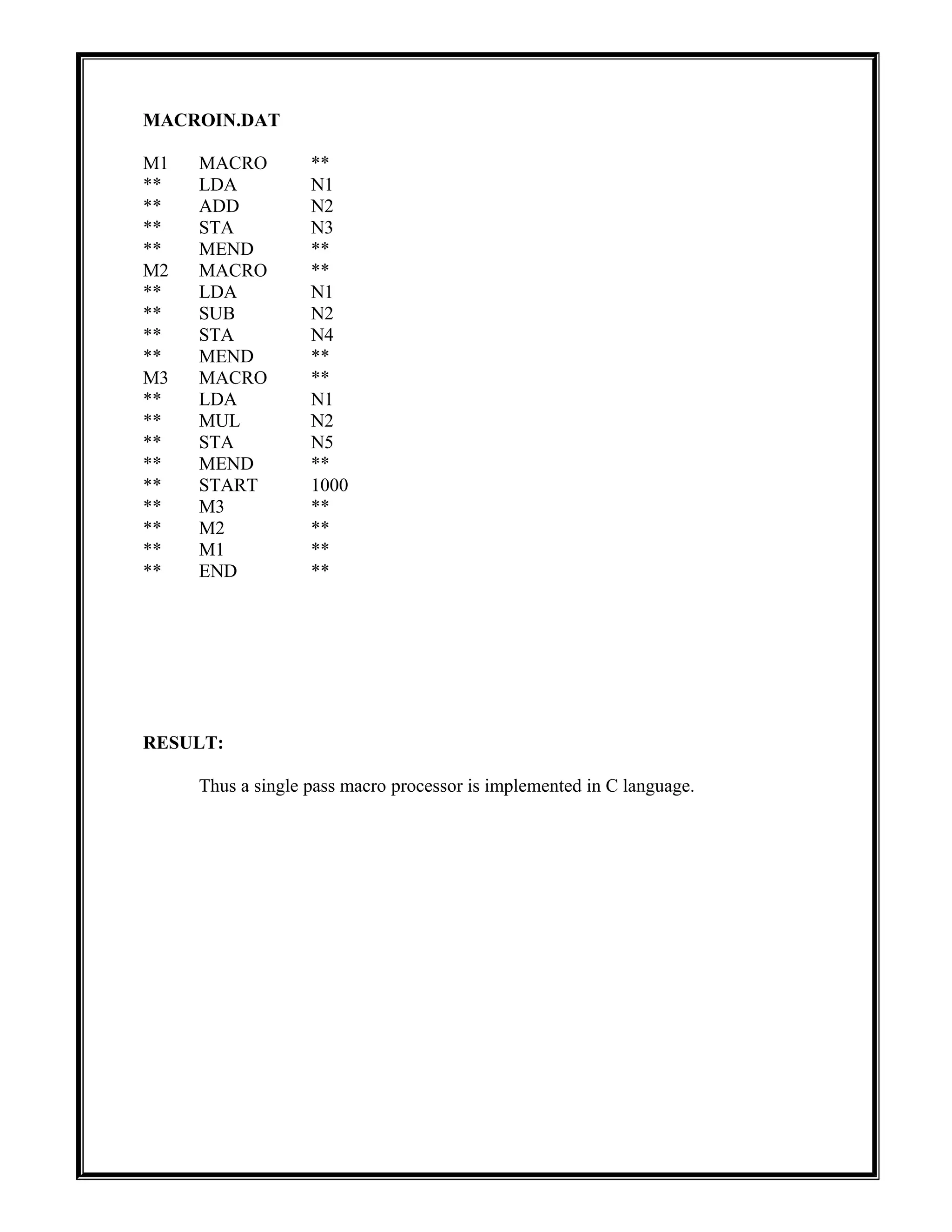
![Ex.No: 07
ABSOLUTE LOADER
AIM:
To implement an Absolute loader in C language.
ALGORITHM:
1. Read the Header record
2. Verify program name and length
3. Read first Text record from the input file
4. Process the following steps until an End record is reached
5.1 If object code is in character form, convert it to internal hexadecimal representation
5.2 Move object codes to specified locations in memory
5.3 Write the starting location counter value of a block of object code and the
corresponding internal representation to the output file
5.4 Read next Text record from the input file
5. Go to the address specified in End record
6. Close all the files and exit
PROGRAM:
/* C Program to implement ABSOLUTE LOADER */
#include<stdio.h>
#include<conio.h>
#include<string.h>
void main()
{
char input[10];
int start,length,address;
FILE *fp1,*fp2;
clrscr();
fp1=fopen("input.dat","r");
fp2=fopen("output.dat","w");
fscanf(fp1,"%s",input);
while(strcmp(input,"E")!=0)
{
if(strcmp(input,"H")==0)
{
fscanf(fp1,"%d",&start);
fscanf(fp1,"%d",&length);
fscanf(fp1,"%s",input);
}
else if(strcmp(input,"T")==0)
{
fscanf(fp1,"%d",&address);
fscanf(fp1,"%s",input);](https://image.slidesharecdn.com/35787646-system-software-lab-manual-150426114600-conversion-gate01/75/35787646-system-software-lab-manual-27-2048.jpg)
![fprintf(fp2,"%dt%c%cn",address,input[0],input[1]);
fprintf(fp2,"%dt%c%cn",(address+1),input[2],input[3]);
fprintf(fp2,"%dt%c%cn",(address+2),input[4],input[5]);
address+=3;
fscanf(fp1,"%s",input);
}
else
{
fprintf(fp2,"%dt%c%cn",address,input[0],input[1]);
fprintf(fp2,"%dt%c%cn",(address+1),input[2],input[3]);
fprintf(fp2,"%dt%c%cn",(address+2),input[4],input[5]);
address+=3;
fscanf(fp1,"%s",input);
}
}
fclose(fp1);
fclose(fp2);
printf("FINISHED");
getch();
}
INPUT.DAT:
H 1000 232
T 1000 142033 483039 102036
T 2000 298300 230000 282030 302015
E
RESULT:
Thus an Absolute loader is implemented in C language.](https://image.slidesharecdn.com/35787646-system-software-lab-manual-150426114600-conversion-gate01/75/35787646-system-software-lab-manual-28-2048.jpg)
![Ex.No: 08
RELOCATING LOADER
AIM:
To implement a Relocating loader in C language.
ALGORITHM:
1. Enter the new starting location to which the object code has to be relocated
2. Read the content of the input file as strings one at a time
3. Transfer the strings from input file to output file, until ‘T’ is encountered
4. Move the consecutive next three strings from input to output
5. Convert the current string, which is the relocation bit associated with each text record to
binary form
6. Make the necessary changes in the corresponding words of object code by adding the new
starting address with the address part of the object code for which the corresponding
relocation bit is set and store the updated object code in the output
7. Move the object code for which the corresponding relocation bit is not set from output to
input without change
8. Repeat steps from 2 to 7 until end record is encountered
9. If object code is in character form, convert it to internal hexadecimal representation
10. Move object codes to specified locations in memory
11. Write the starting location counter value of a block of object code and the corresponding
internal hexadecimal representations to the output file
PROGRAM:
/* C Program to implement RELOCATING LOADER */
#include<stdio.h>
#include<conio.h>
#include<string.h>
#include<stdlib.h>
void main()
{
char add[6],length[10],input[10],bitmask[12],binary[12],relocbit;
int start,len,inp,i,address,opcode,addr,actualadd;
FILE *fp1,*fp2;
clrscr();
printf("Enter the actual starting address: ");
scanf("%d",&start);
fp1=fopen("input.dat","r");
fp2=fopen("output.dat","w");
fscanf(fp1,"%s",input);
while(strcmp(input,"E")!=0)
{
if(strcmp(input,"H")==0)
{
fscanf(fp1,"%s",add);
fscanf(fp1,"%s",length);
fscanf(fp1,"%s",input);](https://image.slidesharecdn.com/35787646-system-software-lab-manual-150426114600-conversion-gate01/75/35787646-system-software-lab-manual-29-2048.jpg)
![}
if(strcmp(input,"T")==0)
{
fscanf(fp1,"%d",&address);
fscanf(fp1,"%s",bitmask);
address+=start;
len=strlen(bitmask);
for(i=0;i<len;i++)
{
fscanf(fp1,"%d",&opcode);
fscanf(fp1,"%d",&addr);
relocbit=bitmask[i];
if(relocbit=='0')
actualadd=addr;
else
actualadd=addr+start;
fprintf(fp2,"%dt%d%dn",address,opcode,actualadd);
address+=3;
}
fscanf(fp1,"%s",input);
}
}
fclose(fp1);
fclose(fp2);
printf("FINISHED");
getch();
}
INPUT.DAT:
H 1000 200
T 1000 11001 14 1033 48 1039 90 1776 92 1765 57 1765
T 2011 11110 23 1838 43 1979 89 1060 66 1849 99 1477
E 1000
Enter the actual starting address: 7000
RESULT:
Thus a Relocating loader is implemented in C language.](https://image.slidesharecdn.com/35787646-system-software-lab-manual-150426114600-conversion-gate01/75/35787646-system-software-lab-manual-30-2048.jpg)
![Ex.No: 09
PASS ONE OF DIRECT LINKING LOADER
AIM:
To implement pass one of direct-linking loader in C language.
ALGORITHM:
1. Enter the location where the program has to be loaded
2. Assign the address got from the user as the first control section address
3. Read the header record of the control section
a. From the details of the header read and store the control section length in a variable
b. Enter the control section name with its address into the external symbol table
4. For each symbol in the subsequent ‘D’ records the symbol must be entered into the
symbol table along with its address, added along with the corresponding control section
until the END record is reached
5. Assign the starting address of next control section as the address of the current control
section plus the length of the control section
6. Repeat the process from step 3 to 5 until there is no more records
PROGRAM:
/* C Program to implement PASS ONE OF DIRECT LINKING LOADER */
#include<stdio.h>
#include<conio.h>
#include<string.h>
#include<stdlib.h>
struct estab
{
char csect[10];
char sym_name[10];
int add,length;
}table[10];
void main()
{
char input[10];
int i,count=0,start,length,loc;
FILE *fp1,*fp2;
clrscr();
fp1=fopen("linkin.dat","r");
fp2=fopen("linkout.dat","w");
printf("nEnter the location where the program has to be located: ");
scanf("%x",&start);
fprintf(fp2,"CSecttSym_NametAddressttLengthnn");
rewind(fp1);
while(!feof(fp1))](https://image.slidesharecdn.com/35787646-system-software-lab-manual-150426114600-conversion-gate01/75/35787646-system-software-lab-manual-31-2048.jpg)
![{
fscanf(fp1,"%s",input);
if(strcmp(input,"H")==0)
{
fscanf(fp1,"%s",input);
strcpy(table[count].csect,input);
strcpy(table[count].sym_name,"**");
fscanf(fp1,"%s",input);
table[count].add=atoi(input)+start;
fscanf(fp1,"%x",&length);
table[count++].length=length;
fscanf(fp1,"%s",input);
}
if(strcmp(input,"D")==0)
{
fscanf(fp1,"%s%x",input,&loc);
while(strcmp(input,"R")!=0)
{
strcpy(table[count].csect,"**");
strcpy(table[count].sym_name,input);
table[count].add=loc+start;
table[count++].length=0;
fscanf(fp1,"%s%x",input,&loc);
}
while(strcmp(input,"T")!=0)
fscanf(fp1,"%s",input);
}
if(strcmp(input,"T")==0)
while(strcmp(input,"E")!=0)
fscanf(fp1,"%s",input);
fscanf(fp1,"%s",input);
start=start+length;
}
for(i=0;i<count;i++)
fprintf(fp2,"%st%stt%xtt%xn",table[i].csect,table[i].sym_name,table[i].add,table[i].length);
fcloseall();
getch();
}
OUTPUT:
Enter the location where the program has to be located: 5075
LINKIN.DAT
H PROGA 000000 000070
D LISTA 000040 ENDA 000054
R LISTB ENDB LISTC ENDC
T 000020 10 032010 77100004 15001
T 000054 16 100014 15100006 00002F 100014](https://image.slidesharecdn.com/35787646-system-software-lab-manual-150426114600-conversion-gate01/75/35787646-system-software-lab-manual-32-2048.jpg)
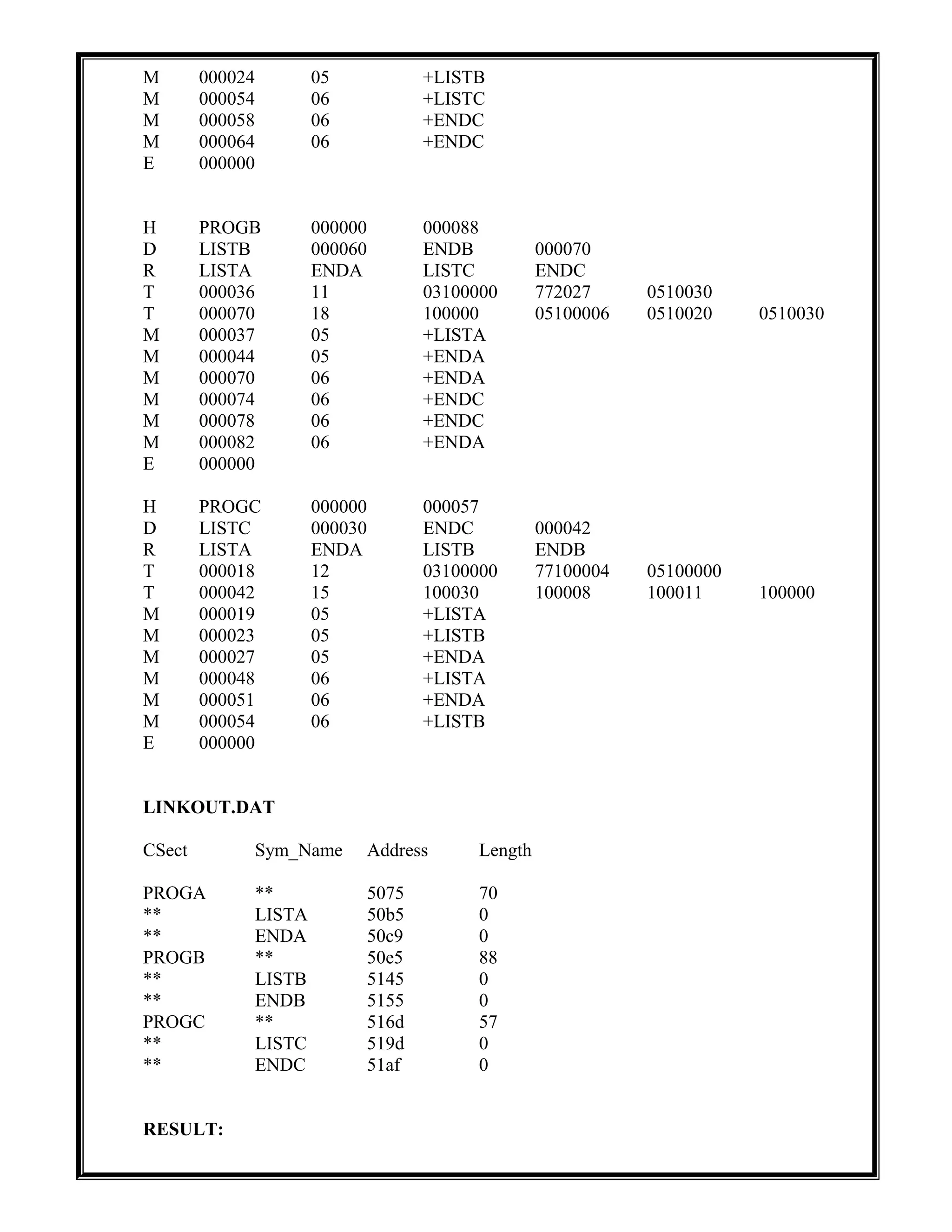

![Ex.No: 10
PASS TWO OF DIRECT LINKING LOADER
AIM:
To implement pass two of direct-linking loader in C language.
ALGORITHM:
1. Enter the location where the program has to be loaded
2. Assign the address got from the user as the first control section address
3. Read the header record of the control section
i. From the details of the header read and store the control section length in a
variable
ii. Enter the control section name with its address into the external symbol table
4. For each symbol in the subsequent ‘D’ records the symbol must be entered into the
symbol table along with its address, added along with the corresponding control section
until the END record is reached
5. Assign the starting address of next control section as the address of the current control
section plus the length of the control section
6. Repeat the process from step 3 to 5 until there is no more records
PROGRAM:
/* C Program to implement PASS TWO OF DIRECT LINKING LOADER */
#include<stdio.h>
#include<conio.h>
main()
{
FILE *fp1,*fp2,*fp3,*fp4,*fp5,*fp6,*fp7,*fp8;
char rec[20],name[20],len[20],t[20],string[1000],mod[40][40],est1[20],est2[20],est4[20],sign[40]
[1],temp;
int ptn1[20][20],ptn2[20][20];
int
l,h=0,lent[20],i,st,m1,m2,start[20],add[20],k=0,est3,z1=0,val[40],ptn[40],offset[40],j,num,progst
art,count=0;
fp1=fopen("DLL_IN.txt","r");
fp2=fopen("ESTAB.txt","r");
fp3=fopen("ntemp.txt","w");
fp4=fopen("memory.txt","w");
fp6=fopen("six.txt","w");
fscanf(fp1,"%s%s%x%s",rec,name,&st,len);
for(l=0;l<3;l++)
{
if(l==1)
fp3=fopen("ntempb.txt","w");
if(l==2)
fp3=fopen("ntempc.txt","w");](https://image.slidesharecdn.com/35787646-system-software-lab-manual-150426114600-conversion-gate01/75/35787646-system-software-lab-manual-35-2048.jpg)
![fscanf(fp1,"%s",t);
do{
if(strcmp(t,"T")==0)
{
fscanf(fp1,"%x%x",&start[h],&lent[h]);
if(h!=0) {
for(i=0;i<(start[h]-(start[h-1]+lent[h-1]));i++)
fprintf(fp3,"x");
}
h++;
fscanf(fp1,"%s",t);
do{
fprintf(fp3,"%s",t);
fscanf(fp1,"%s",t);
}while((strcmp(t,"T")!=0)&&(strcmp(t,"M")!=0));
}
else if(strcmp(t,"M")==0)
{
fscanf(fp1,"%x%x%s%s",&ptn[k],&offset[k],sign[k],mod[k]);
fscanf(fp2,"%s%s%x%s",est1,est2,&est3,est4);
progstart=est3;
do{
if(strcmp(mod[k],est2)==0){
val[z1]=est3;
z1++;
break;
}
else if(strcmp(mod[k],est1)==0) {
val[z1]=est3;
z1++;
break;
}
fscanf(fp2,"%s%s%x%s",est1,est2,&est3,est4);
}while(!feof(fp2));
rewind(fp2);
fscanf(fp1,"%s",t);
k++;
}
else if(strcmp(t,"E")==0)
{
fscanf(fp1,"%s",t);
if(l!=2)
fscanf(fp1,"%s%s%x%s",rec,name,&st,len);
break;
}
else if(strcmp(t,"R")==0)
{
while(strcmp(t,"T")!=0)
fscanf(fp1,"%s",t);
}
else if(strcmp(t,"D")==0)](https://image.slidesharecdn.com/35787646-system-software-lab-manual-150426114600-conversion-gate01/75/35787646-system-software-lab-manual-36-2048.jpg)
![{
while(strcmp(t,"R")!=0)
fscanf(fp1,"%s",t);
}
}while(1);
fclose(fp3);
for(i=0;i<k;i++){
if(l==0)
fp3=fopen("ntemp.txt","r+");
if(l==1)
fp3=fopen("ntempb.txt","r+");
if(l==2)
fp3=fopen("ntempc.txt","r+");
fp5=fopen("temp1.txt","w");
fseek(fp3,(ptn[i]*2)+1,0);
for(j=0;j<offset[i];j++)
{
fscanf(fp3,"%c",&temp);
fprintf(fp5,"%c",temp);
}
fprintf(fp5,"n");
fclose(fp5);
fp5=fopen("temp1.txt","r");
fscanf(fp5,"%x",&num);
if(sign[i][0]=='+')
{
num=num+val[i];
fseek(fp3,(ptn[i]*2)+1,0);
if(offset[i]==5)
fprintf(fp3,"0%x",num);
else
fprintf(fp3,"00%x",num);
}
else
{
num=num-val[i];
fseek(fp3,(ptn[i]*2)+1,0);
fprintf(fp3,"00%x",num);
}
fclose(fp3);
fclose(fp5);
}
k=0;h=0;z1=0;
}
fp3=fopen("ntemp.txt","r");
fscanf(fp3,"%s",string);
fclose(fp3);
fprintf(fp6,"%s",string);
fp3=fopen("ntempb.txt","r");
fscanf(fp3,"%s",string);
fclose(fp3);](https://image.slidesharecdn.com/35787646-system-software-lab-manual-150426114600-conversion-gate01/75/35787646-system-software-lab-manual-37-2048.jpg)
![fprintf(fp6,"%s",string);
fp3=fopen("ntempc.txt","r");
fscanf(fp3,"%s",string);
fclose(fp3);
fprintf(fp6,"%s",string);
fclose(fp6);
fp6=fopen("six.txt","r");
fscanf(fp6,"%s",string);
for(i=0;i<strlen(string);i++)
{
if(i==0) {
fprintf(fp4,"%xt",progstart);
progstart+=16;
}
if((i%8==0)&&(i!=0))
fprintf(fp4,"t");
if((i%32==0)&&(i!=0)) {
fprintf(fp4,"n");
fprintf(fp4,"%xt",progstart);
progstart+=16;
}
fprintf(fp4,"%c",string[i]);
}
return 0;
}
DLL_IN.TXT
H PROGA 000000 00003A
D LISTA 000030 ENDA 000050 .
R LISTB LISTC ENDC
T 000000 1D 172027 4B100000 032023 290000 332007 4B100000 3F2FEC 032016 0F2016
T 00001D 0D 010003 0F200A 4B100000 3E2000
M 000004 05 + LISTB
M 000011 05 + LISTC
E 000000
H PROGB 000000 00002E
D LISTB 000060 ENDB 000070 .
R LISTA ENDA
T 000000 1D B410 B400 B440 77201F E3201B 332FFA DB2015 A004 332009 57900000 B850
T 000020 0E 3B2FE9 13100000 4F0000 F1000000
M 000007 05 + LISTA
M 000022 05 + ENDA
E 000000
H PROGC 000000 00001C
D LISTC 000030 ENDC 000042 .
R LISTA ENDA
T 000000 1C B410 77100000 E32012 332FFA 53900000 DF2008 B850 3B2FEE 4F000005
M 000006 05 + LISTA
M 000013 06 + ENDA
E 000000](https://image.slidesharecdn.com/35787646-system-software-lab-manual-150426114600-conversion-gate01/75/35787646-system-software-lab-manual-38-2048.jpg)
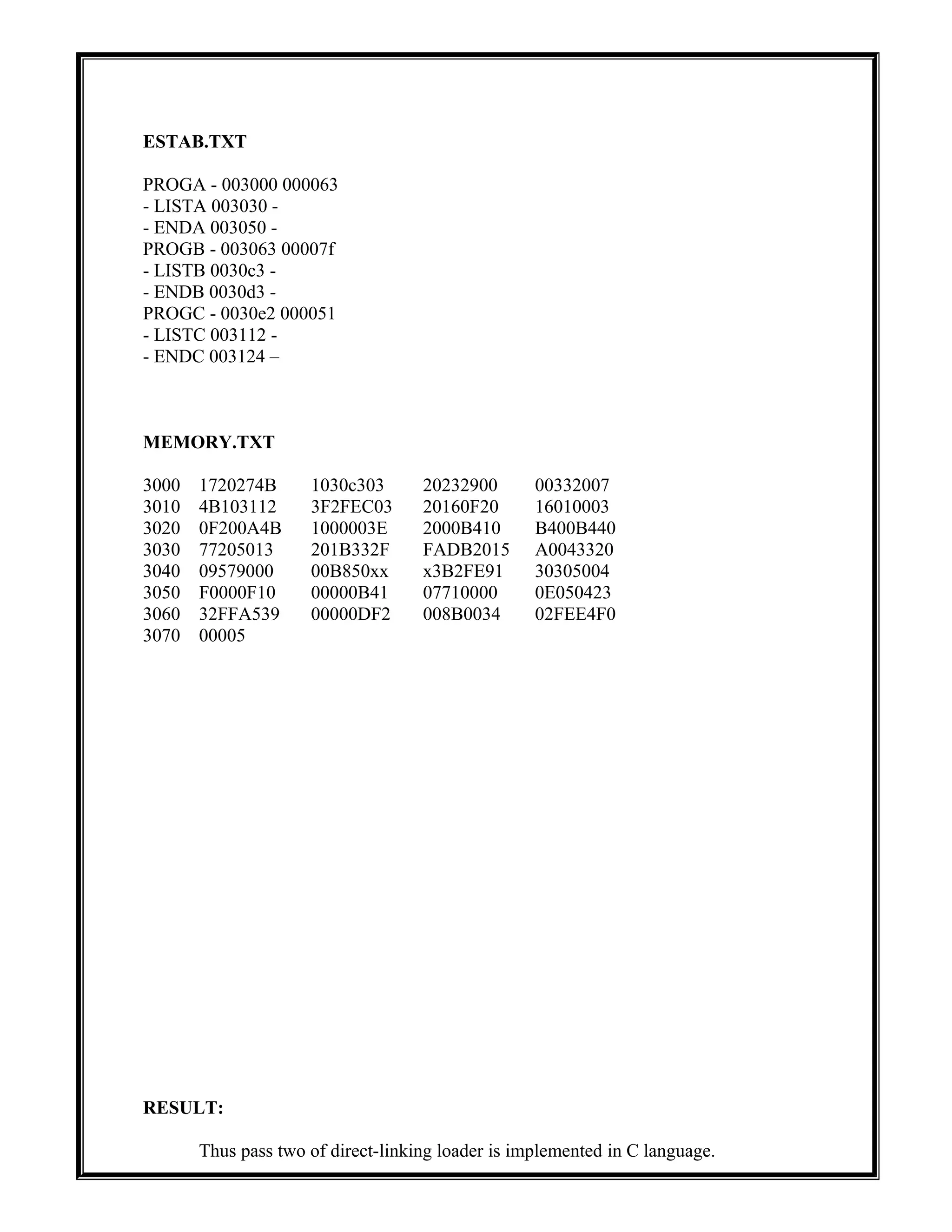

![newf();
break;
case 2:
view();
break;
case 3:
saveas();
break;
case 4:
modify();
break;
case 5:
exit(0);
default:
printf("nWrong choice!!!");
break;
}
}while(op!=5);
}
void newf()
{
FILE *f;
char fname[20],c;
printf("nEnter the Filename: ");
scanf("%s",fname);
printf("nType the content and CTRL+Z to terminate:n");
f=fopen(fname,"w");
rewind(f);
while((c=getchar())!=EOF)
{
putc(c,f);
}
fclose(f);
}
void view()
{
FILE *f;
char fname[20],c;
printf("nEnter the name of the file:");
scanf("%s",&fname);
if(searchpath(fname))
{
f=fopen(fname,"r");
while((c=getc(f))!=EOF)
{
printf("%c",c);
}
}
else
printf("nThe file %s does not exist",fname);
fclose(f);](https://image.slidesharecdn.com/35787646-system-software-lab-manual-150426114600-conversion-gate01/75/35787646-system-software-lab-manual-41-2048.jpg)
![}
void saveas()
{
FILE *f1,*f2;
char c,sou[20],des[20];
printf("nEnter the Source file name: ");
scanf("%s",sou);
if(searchpath(sou))
{
printf("Enter the Destination file name: ");
scanf("%s",des);
f1=fopen(sou,"r");
f2=fopen(des,"w");
while((c=getc(f1))!=EOF)
{
putc(c,f2);
}
fclose(f1);
fclose(f2);
}
else
printf("nFile does not exist");
getch();
}
void modify()
{
int ch1;
FILE *f1;
char c,*word,*sent,fname[20];
printf("Enter the filename to be modified: ");
scanf("%s",fname);
if(searchpath(fname))
{
printf("n1.Character");
printf("n2.Word");
printf("n3.Sentence");
printf("nEnter U'r choice: ");
scanf("%d",&ch1);
if(ch1==1)
{
f1=fopen(fname,"a+");
fseek(f1, 0L, SEEK_END);
printf("Enter the character and CTRL+Z to exit:n ");
while((c=getchar())!=EOF)
{
putc(c,f1);
}
}
else if(ch1==2)
{
printf("Enter the word: ");](https://image.slidesharecdn.com/35787646-system-software-lab-manual-150426114600-conversion-gate01/75/35787646-system-software-lab-manual-42-2048.jpg)
